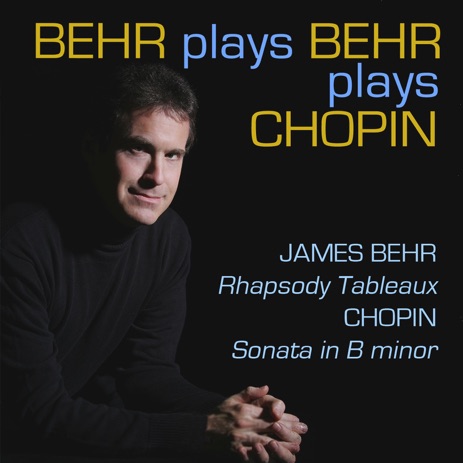CHOPIN: SONATA IN B MINOR, OP. 57
James Behr, piano
The B minor Sonata is a special work. Dedicated to Madame la Comtesse Emilie de Perthuis, a piano student and friend, Chopin wrote it in the summer of 1844 at his seaside getaway. He left Paris to soothe health problems, but the dampness of the sea air likely hurt matters. Poor health plagued him, which is striking given the work's optimistic tone amidst a losing battle with tuberculosis. He had coughing fits so horrible that summer that he coughed up blood. He once fainted and was found on the floor by his mistress, writer George Sand, who lived with him. He never performed the sonata in public. He was 34, weak, perhaps sensing the inevitable. He had five years to live. What a work of genius this turned out to be. The majestic first movement uses standard sonata-allegro form: first and second themes, development, recapitulation. For all its romanticism, the movement shows comfort with Classical form and Baroque counterpoint (devilish to play) displaying brilliant fugal writing atypical of the Romantic era. The second movement, the scherzo (Italian for “joke”), is fast and fun. It curiously contradicts the realities of Chopin's poor health. Its “trio” section is sheer genius, lushly melodic, returning to the bubbly opening. The third movement, of his nocturne style, reflects maturity and elegiac gravitas. Sandwiched within is a sentimentalism – as if reminiscing on better times. The sweeping finale, in rondo form (ABACA), is five minutes of dazzle and glory. The exoticism of Chopin harmonies reflects his Polish roots and originality unlike anyone before or since.
JAMES BEHR: RHAPSODY TABLEAUX
Behr completed Rhapsody Tableaux in 2007 following the loss of his beloved stepfather, Leo Breslau, a gifted artist whose works are displayed throughout the U.S., including The National Gallery of Art. The word “tableaux” (in French, picturesque scenes) was chosen to honor Mr. Breslau and reflect Rhapsody: a series of colorful musical vignettes. In this exciting and melodic work with moods ranging from jazzy to profound, Behr creates a uniquely American musical tableaux, a style he calls “Blue Age.” Rhapsody follows a loose sonata-allegro form, opening with a melodic idee fixe that becomes its foundation. The idee fixe is heard often and in varying moods. Following the lush introduction is a pulsating second theme, which, says the composer, “Brings me to the streets of New York” (where he lives). Colorful passages follow, ranging from charming to “scherzotic.” The enchanted “Sentimental“ arrives with two romantic melodies, followed by “Misterioso” (development) with a haunting reprise of the idee fixe. Recapitulation comes in the finale “Glory” flowing with joyful and ragtime-ish episodes. Rhapsody concludes with driving, rhythmic passages of Rachmaninoff-like flair. reaching an exciting, final affirmation of the idee fixe.
1. CHOPIN: Allegro maestoso
2. CHOPIN: Scherzo
3. CHOPIN: Largo
4. CHOPIN: Presto, ma non tanto
8. BEHR: Rhapsody "Glory"
5. BEHR: Rhapsody "Majesty"
7. BEHR: Rhapsody "Misterioso"
6. BEHR: Rhapsody "Sentimental"



